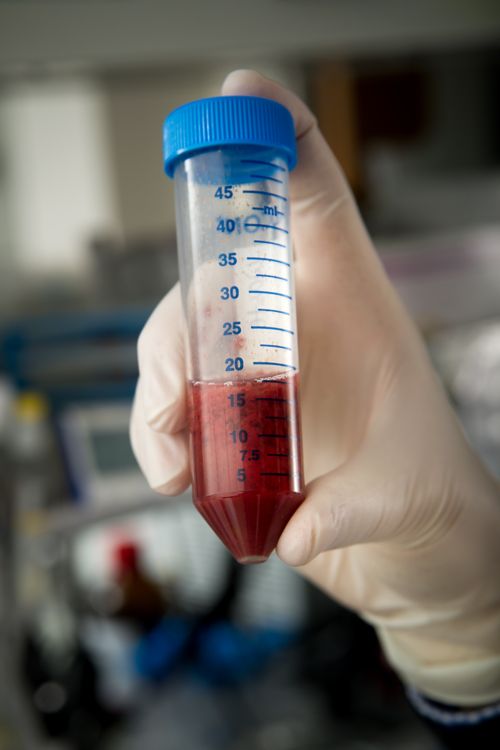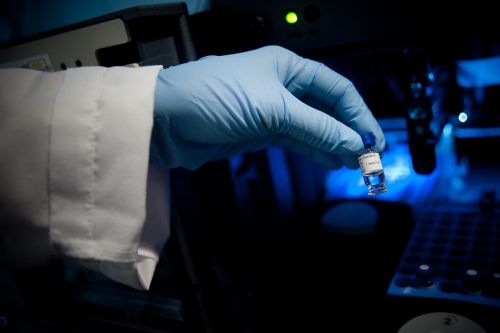St. Jude Family of Websites
Explore our cutting edge research, world-class patient care, career opportunities and more.
St. Jude Children's Research Hospital Home

- Fundraising
St. Jude Family of Websites
Explore our cutting edge research, world-class patient care, career opportunities and more.
St. Jude Children's Research Hospital Home

- Fundraising
St. Jude's contribution to two new durable 'one-time' hemophilia drugs

Hemophilia is a rare bleeding disorder in which the blood does not clot properly, resulting in extended bleeding time after an injury or internal bleeding, which may be life threatening. Many individuals with hemophilia become physically or mentally disabled from chronic joint damage due to bleeding. Hemophilia is caused by the blood having little or none of a specific plasma protein, or clotting factor, which is needed for normal clotting.
There are 3 types of hemophilia, based on which clotting factor is low or missing, A and B are the most common:
- Hemophilia A — caused by a deficiency of clotting factor VIII
- Hemophilia B — caused by a deficiency of clotting factor IX
- Hemophilia C — caused by a deficiency of clotting factor XI
Conventional treatment for hemophilia is based on the severity of the condition in each individual; along with their activity level and need for future medical or dental procedures. The main treatment is clotting factor replacement therapy, administered prophylactically, usually several times a week. More recently, a non-factor monoclonal antibody administered every one to four weeks has become available for hemophilia A which provides a more consistent bleed protection. Other promising non-factor products for hemophilia A and B are still in clinical trials. In contrast to these conventional therapies which must be administered over and over, a gene therapy for hemophilia B developed using St. Jude intellectual property offers a more permanent solution.

On November 22, 2022, Hemgenix (etranacogene dezaparvovec-drlb) was the first gene therapy for the treatment of adults living with hemophilia B to be approved by the Food and Drug Administration (FDA). Hemgenix emerged from pioneering work by St. Jude, led by Drs. Andrew Davidoff and John Gray, and the University College London (UCL), led by former St. Jude post doc Amit Nathwani. It was licensed to uniQure, who partnered with CSL Behring to produce the single-dose treatment to reduce abnormal bleeding by enabling continuous production of factor IX in the liver. It uses an adeno-associated viral (AAV) vector, AAV5, to deliver a Factor IX gene variant utilizing a promoter and optimized codons developed at St. Jude. The genetic instructions remain in those cells to allow stable production levels of factor IX.
On June 29, 2023, Roctavian (valoctocogene roxaparvovec) was the first gene therapy for adults with severe hemophilia A to be approved by the FDA. The European Commission had previously approved Roctavian in August 2022. Roctavian is a single-dose treatment for people with hemophilia A using an AAV5-type vector carrying the Factor VIII gene into liver cells enabling a persistent increase of their levels of factor VIII. This has improved their body’s ability to control bleeding without regular injections. The vector used in this treatment was largely developed by the same team at St. Jude and UCL that had developed Hemgenix. It was licensed to BioMarin Pharmaceuticals, Inc. in 2013.
The FDA approval was supported by results from BioMarin’s pivotal GENEr-8 trial, the longest global phase 3 study to date for any gene therapy in hemophilia A. The therapy was shown to be effective in reducing the rate of bleeding in a cohort of 134 patients for at least three years. Participants in the Phase 2 study have been observed for more than 5 years with evidence of diminishing factor levels over time in some.

Andrew Davidoff, MD
Liver-Specific Promotor Available for License in Other Fields
Though the liver-specific promoter with shortened regulatory regions is exclusively licensed for use with hemophilia B gene therapy, the promoter can be licensed nonexclusively in other fields. The size can be adjusted to improve expression levels, which is key for making gene therapy effective in humans. We believe it can be further used to express many genes of interest in a size-constrained environment, such as in a self-complementary gene therapy vector system. Please contact us if you are interested in learning more about this groundbreaking advancement in gene therapy.

Nickhill Bhakta, MD
Ongoing Work to Develop an Inexpensive Global Solution
The 2014 research (N Engl J Med. 2014 Nov 20;371(21):1994-2004. doi: 10.1056/NEJMoa1407309) suggested one infusion of a factor IX gene-carrying vector can achieve long-term factor IX levels high enough to prevent most to all abnormal bleeding without the need for repeated administration of factor concentrate. The unique vector designed to express blood clotting protein factor IX was originally manufactured at Children’s GMP, LLC, at St. Jude. So, while a later development has become an approved treatment in the US and Europe, the original intent was to create a proof-of-principle for establishing gene therapy programs in low- and middle-income countries (LMICs) and to help move this treatment option to countries that may not have the resources to develop and support this technology on their own. That work continues as St. Jude and the World Federation of Hemophilia (WFH) collaborated on an international gene therapy clinical trial for older adolescents and adults with hemophilia B. About 75% of hemophilia B (factor IX deficiency) patients live in LMICs with extremely limited access to factor IX concentrate for treatment. Nickhill Bhakta, MD, Global Pediatric Medicine led an interesting cost-effective analysis comparing factor replacement and gene therapy.